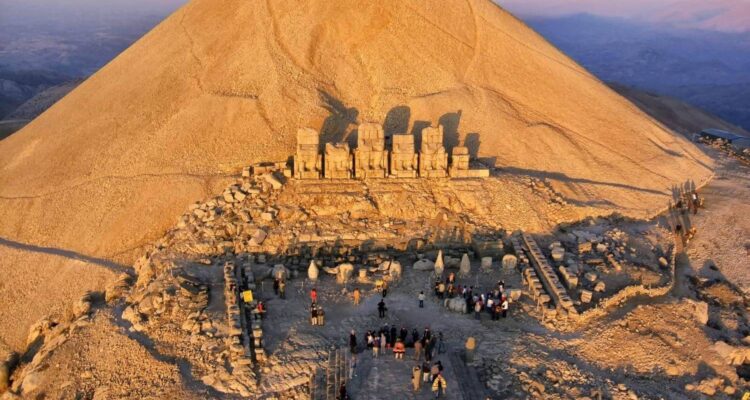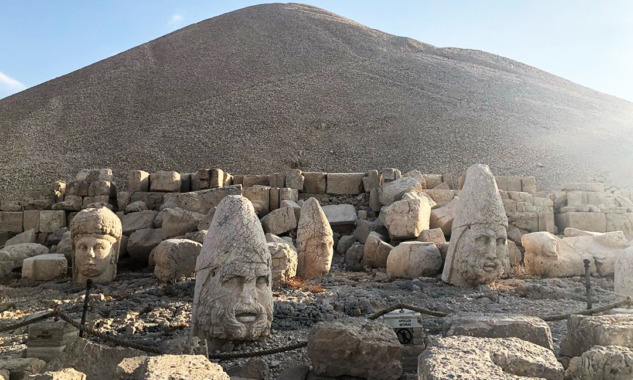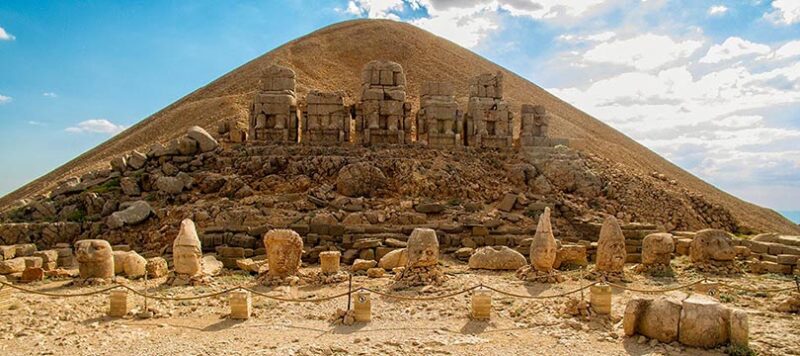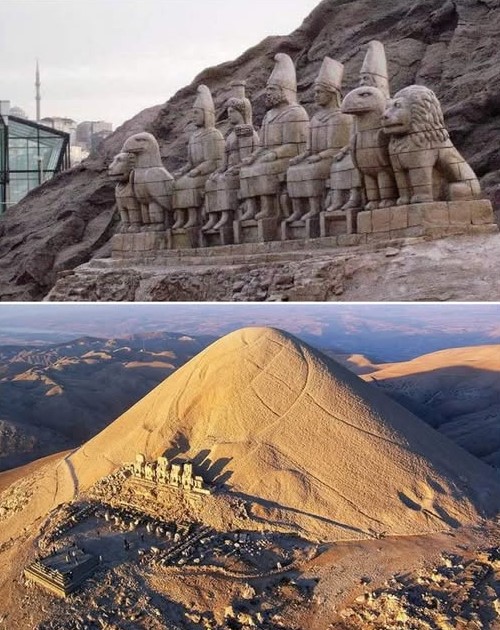Imagine a majestic mountaintop crowned with colossal statues, their weathered countenances gazing across the vast landscape. This is Mount Nemrut, a mystical peak nestled in southeastern Turkey, a testament to the ambition of King Antiochus I of Commagene. In the 1st century BCE, he commissioned the construction of this remarkable complex, featuring monumental sculptures of gods and himself, creating a unique blend of Greek, Persian, and Armenian religious traditions. Today, despite the ravages of time, Mount Nemrut remains a breathtaking UNESCO World Heritage Site, especially captivating at sunrise and sunset. Follow archeology.dulichvn.net to discover many hidden mysteries that have yet to be discovered.

The Royal Sanctuary of Antiochus I
Mount Nemrut was conceived as a royal sanctuary, a final resting place for King Antiochus I and a testament to his divine lineage and power. The site’s design and execution reflect a complex interplay of religious and political motivations.
A Synthesis of Cultures and Religions
The statues on Mount Nemrut represent a fascinating fusion of Greek, Persian, and Armenian deities, reflecting the cultural influences present in the Kingdom of Commagene.
- Syncretism of Deities: Antiochus I strategically blended Greek gods like Zeus (identified with the Persian Ahura Mazda), Hercules (identified with the Persian Verethragna), and Apollo (identified with Mithra) with local Armenian and Persian deities, creating a syncretic pantheon. This fusion aimed to unify his diverse kingdom under a shared religious identity.
- Royal Cult and Divine Ancestry: Antiochus I promoted a royal cult, claiming descent from both Alexander the Great and Darius I of Persia, thus legitimizing his rule and associating himself with divine ancestry. The statues on Mount Nemrut served as a powerful visual representation of this divine lineage.
- A Message of Universal Rule: By combining elements from different cultures and religions, Antiochus I sought to project an image of universal rule and divine authority, appealing to the diverse populations within his kingdom and beyond.
The Monumental Statues and Terraces
The most striking feature of Mount Nemrut is the collection of colossal statues that once adorned the mountaintop. These statues, along with the surrounding terraces, form a carefully planned complex.
- Colossal Scale and Symbolic Power: The sheer size of the statues, originally reaching heights of 8-9 meters (26-30 feet), was intended to impress and awe visitors, conveying the king’s power and connection to the divine. Their monumental scale emphasized their significance within the sanctuary.
- Eastern and Western Terraces: The site is divided into eastern and western terraces, each featuring rows of seated statues. The eastern terrace was primarily used for sunrise ceremonies, while the western terrace was used for sunset ceremonies. This orientation highlights the importance of celestial events in the site’s design.
- The Fallen Heads: A Dramatic Scene: Over time, earthquakes and other natural forces have caused the heads of the statues to fall from their bodies. These fallen heads, scattered across the terraces, create a dramatic and haunting scene, adding to the site’s mystique.
The Inscription and its Significance
A long inscription in Greek, detailing Antiochus I’s intentions and beliefs, was carved on the site. This inscription provides valuable insights into the king’s motivations and the religious context of the monument.
- A Royal Decree and Testament: The inscription serves as a royal decree, outlining the purpose of the sanctuary and detailing the rituals and ceremonies that were to be performed there. It also acts as a personal testament of Antiochus I’s beliefs and worldview.
- Insights into Commagene History and Culture: The inscription provides valuable historical information about the Kingdom of Commagene, its political structure, and its cultural influences. It offers a unique window into the region’s history during the Hellenistic period.
- Preservation and Decipherment Efforts: Scholars have dedicated significant efforts to preserving and deciphering the inscription, which continues to be a source of ongoing research and interpretation.

Experiencing the Majesty of Mount Nemrut
Visiting Mount Nemrut is a truly unforgettable experience, particularly at sunrise or sunset, when the interplay of light and shadow creates a magical atmosphere.
Sunrise and Sunset Spectacles
The breathtaking views from Mount Nemrut, especially at sunrise and sunset, are a major draw for visitors.
- Golden Light and Dramatic Shadows: The golden light of sunrise and sunset bathes the statues and the surrounding landscape in a warm glow, creating dramatic shadows and highlighting the intricate details of the sculptures. This interplay of light and shadow enhances the visual impact of the site.
- Panoramic Views of the Surrounding Landscape: From the summit of Mount Nemrut, visitors can enjoy panoramic views of the surrounding landscape, including the Taurus Mountains and the Euphrates River valley. These stunning vistas add to the overall experience.
- A Sense of Awe and Wonder: Witnessing the sunrise or sunset from Mount Nemrut evokes a sense of awe and wonder, transporting visitors to a world of myth and legend. The combination of the ancient sculptures and the natural beauty of the landscape creates a truly magical atmosphere.
Exploring the Archaeological Site
Exploring the archaeological site allows visitors to connect with the history and culture of the region.
- Walking Among the Fallen Heads: Walking among the fallen heads of the statues is a poignant experience, prompting reflection on the passage of time and the fragility of human endeavors.
- Examining the Terraces and Remains: Exploring the terraces and other remains of the complex provides insights into the site’s original layout and function.
- Understanding the Site’s Historical Context: Learning about the history of the Kingdom of Commagene and the motivations behind the construction of Mount Nemrut enhances the visitor experience and provides a deeper understanding of the site’s significance.
A UNESCO World Heritage Site and its Preservation
Mount Nemrut’s designation as a UNESCO World Heritage Site underscores its global cultural significance and the importance of its preservation.
- Recognizing Global Cultural Significance: The UNESCO designation recognizes Mount Nemrut’s exceptional universal value and its importance as a cultural heritage site.
- Conservation and Preservation Efforts: Ongoing efforts are dedicated to conserving and preserving the site for future generations, including stabilizing the statues and protecting them from further deterioration.
- Promoting Sustainable Tourism: Sustainable tourism practices are promoted to ensure that visitors can enjoy the site without causing further damage to its fragile environment and historical remains.

Mount Nemrut stands as a powerful reminder of the ambition and vision of King Antiochus I, a unique blend of cultures and religions, and a testament to the enduring power of human creativity. Its dramatic setting and captivating history continue to inspire awe and wonder in all who visit.


CÁC TIN KHÁC
Mary Walton: The Forgotten Inventor Who Helped Clean Up America’s Cities
Tomb of Queen Nefertari in the Valley of the Queens, Egypt
Discover the Hypostyle Hall of the Temple of Hathor at Dendera
Venus de Losange: Unveiling the Mystery of a 20,000-Year-Old Paleolithic Icon